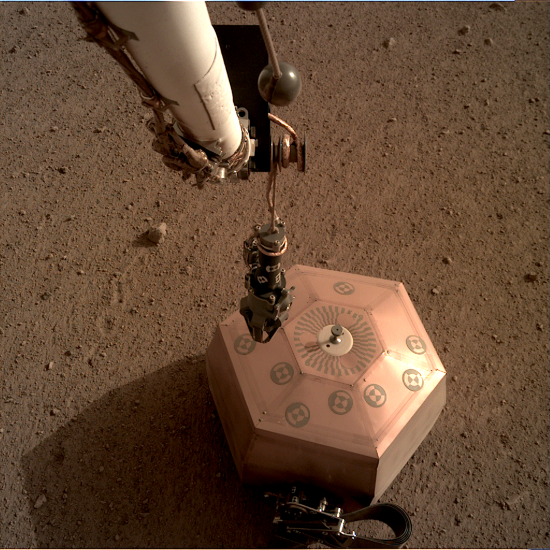
Jan 11, 2019
Do marsquakes exist?
NASA launched the InSight Mars lander from Vandenberg Air Force Base on May 5, 2018. The mission’s primary focus is the detection of marsquakes. In the image at the top of the page, InSight is placing the Seismic Experiment for Interior Structure seismometer on Mars, in order to monitor ground motion. Mars is thought to shake from meteor impacts, or from any volcanic activity still present, although there is no evidence for such disturbances.
Philippe Lognonné, Principal Investigator said:
“We’ve been waiting for this moment for a long time. It’s been 130 years since the first seismic record on Earth and almost 50 years since a seismometer was placed on the Moon during the Apollo program. What we learn from SEIS will shed light on how Mars formed and evolved.”
A primary assumption about Mars, as well as the other rocky bodies, is that they evolved in a clockwork Solar System, with no catastrophes allowed, except for rare events like large asteroid strikes—and those are supposed to happen every few million years. The mission is another attempt to understand why Earth and Mars are so different; presuming that they both came out of the same nebular cloud. Ignoring electricity in space means that variability in planets is mysterious to the consensus.
The atmosphere on Mars averages 75 degrees colder, with an atmospheric density that is 0.6% that of Earth. It is the equivalent to standing on a mountain on Earth that is 35 kilometers high. It is also dry, with only some suggestions of water ice. InSight is a water hunter, since without water in the form of subsurface ice, the chances of finding life on Mars are slim.
InSight touched down in the Elysium Planitia region, about 600 kilometers from where the Mars Science Laboratory, Curiosity, is exploring Mount Sharp in Gale Crater. The landing area was chosen from among 22 candidate sites for safety: a flat surface with no large boulders, slopes, cracks or depressions. This is because the platform must remain stable and be able to use its solar panels effectively.
Several Mars missions sought, and are seeking, confirmation for the existence of water in some form or another on the Red Planet. There were reports of clouds and low-lying fog—and the Phoenix polar lander is reputed to have detected water just below the surface—but nothing definitive. For example, although the now defunct Phoenix lander reported visual evidence for water, the probes used to test for water in the soil returned a null reading. The soil was nonconductive, indicating no water molecules.
As nearly every consensus presentation about Mars insists, the planet must have gone through a stage when there were oceans of water on the surface. The concept implies that Mars once retained an atmosphere dense enough in oxygen (and a moderating gas) so that life could live in the open.
In an Electric Universe, powerful electric arcs once impacted the surface of Mars. The energy released by those discharges created sinuous rilles, flat-floored craters, “railroad track” patterns in canyons and craters, intersecting gullies with no debris inside them, giant mesas with Lichtenberg “cathode whiskers” and steep-sided ravines wending through landscapes dotted with circular uplifts.
Martian topography is not rounded or softened as if by a flood. It does not conform to slow weathering by rainfall or blowing dust. The formations on Mars are sharp, angular and fresh looking, as if sculpted quickly and with tremendous force. The northern latitudes, in particular, are effaced.
Since the past calamities were so all-consuming, it can be generally assumed that no life will be found on Mars.
Stephen Smith












